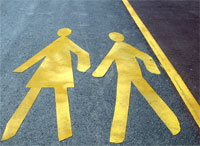Can you easily stay fit while walking to a nearby grocery store to shop for food and simultaneously saving money on gas, parking, and repairs? Is your neighborhood affecting your well-being?
Check out these articles and ideas on creating communities that are more walkable, with a balance of stores, schools, and homes.
Find out your neighborhood’s Walk Score here.
About walkable neighborhoods
There’s a connection between community design and health. A growing body of research shows that well-designed, compact communities can promote good health by:
- reducing car crashes;
- promoting exercise and thus reducing the risk of obesity;
- reducing vehicle-related air pollution;
- and (possibly) by promoting social ties that buoy health.
In other words, walkable neighborhoods provide multiple benefits.
Maps and graphics about walkability
A Suburban Community: Walkability within One Mile
A Compact Community: Walkability within One Mile
Solutions for creating walk- and bike-friendly places
Solutions for Healthier Communities
Designing cities for health
Why Bikes Are a Sustainable Wonder
The most energy-efficient form of travel. It’s also healthy.
More Parks, Less Parking
Small changes to parking policy can make a big difference.
Thoughts on walkability from Sightline Daily
The Year of Living Carlessly Experiment
Alan Durning’s writing on living car-free.







